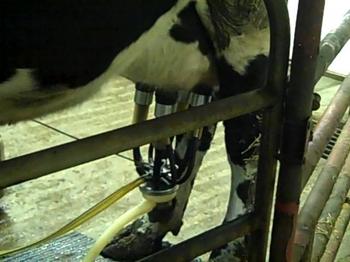Calder Dairy: mooing with activity
In my Farm to Fork series I visit local farms around Ann Arbor and share what I learn.

A cow attached to the milch machine.
Corinna Borden | Contributor
25 years later, as I walked around Calder Dairy in Carleton, I still feel very small and am still captivated by the many animals contained under the rubric of “dairy” farm.
Calder Dairy has been family owned and operated since 1946. The 60 years of experience was evident to me when I called for a tour. The nice woman on the phone responded to my query - “Just show up and walk around. You can ask questions and anyone would be happy to help you. We are an open farm.” So walk around I did.
There were cows grazing, large horses meandering, cows eating in an open barn, goats pausing in front of the bunny hutch, mini horses scratching themselves on the fence, bulls staring at cows, a new calf suckling its mother, chickens strutting, peacocks stretching, geese chasing, ganders yodeling, and yes, even kittens scampering. Clicks, clucks, thrums, moos, chewing, crowing, meowing, and preening noises filled the air with a cushion of sound. The smell was barnyard, without being overwhelming.
A few herd facts before we visit the milching room.

Just like their trucks, Calder Dairy barns are painted with the distinctive Holstein markings.
Corinna Borden | Contributor
I spent the majority of my time sitting in the viewing room with a curious rooster captivated and hypnotized by the milking process (I think the rooster was just captivated with himself). The cows were cheek by jowl and patiently waiting for their turn. It looks like a gas station where instead of withdrawing gasoline, cows deposit milk. Like a gas station, the players seemed automatic in their routine. Given that milking happens twice a day, 365 days a year, routine is a good word for it.
Three handlers man the 8 spots where the cows walk onto a platform. Their udder is sprayed and wiped and then four suction clamps are placed on their teats. The rhythmic pumping of the machine pulses the fresh milk into holding tanks where it is stored until they take it to their Lincoln Park facility to be pasteurized.
I sat for about 30 minutes, in awe of these huge creatures so full of milk. (If you want to meditate for 30 seconds on a cow being milked, here is a video.) Some of the animals seemed older, their hipbones jutting out, almost unable to step up the 12 inches to the platform, yet with resplendent swaying udders the size of large watermelons.
Watching those huge lumbering creatures, bred for hundreds of years to maximize return on a farmer’s efforts, I felt in awe at the amount of dedication and work dairy farmers give every day of the year to bring milk to the cereal bowls of America. From those pendulous udders is pumped ice cream, egg nog, cottage cheese, cream for coffee, crème brulee, lattes, hot chocolate, on and on.
The farm is a perfect place for an afternoon outing, perhaps when it is warm enough that one could sit under their pavilion by the pond and watch the very friendly geese while enjoying one of their 38 flavors of ice cream. If you have a group of 15 of more, contact Calder Dairy for a farm tour, they will let you feed the calves!
The Farm to Fork series focuses on local farms around Ann Arbor. If you would like me to visit your farm drop me a line and say hello. You can also check out my website!


Comments
Corinna Borden
Tue, Nov 24, 2009 : 9:16 p.m.
hi dairydream! thank you so much for asking this question! I have a vivid memory of reading Laura Ingalls Wilder's books - and there is one where they are stuck in a blizzard and they have NO food. Her father walks out with his "milch pail" and laura asks if there is a "milch cow" in town. For some reason, the word stuck with me. I googled it when I wrote this and it is, in fact, an adjective meaning milk from the Middle English "milche" - I have a degree in Middle English, so it made me smile when I used the word. Thanks for noticing!
dairydream
Tue, Nov 24, 2009 : 2:18 p.m.
When you said "milching", did you mean "milking"?